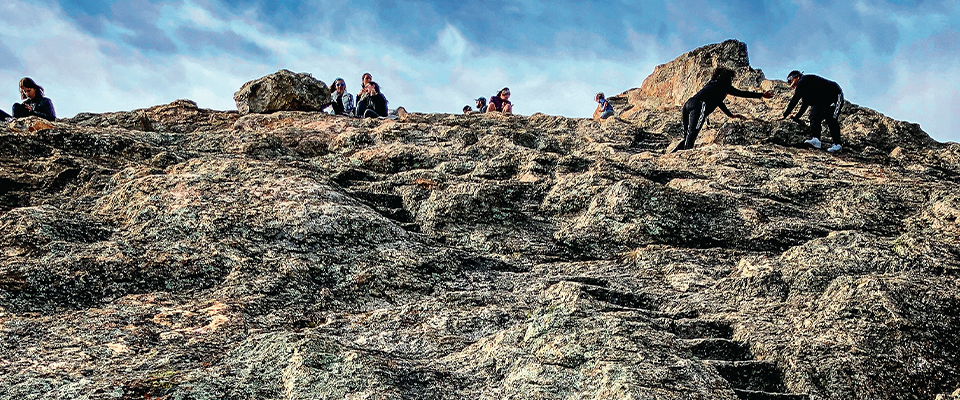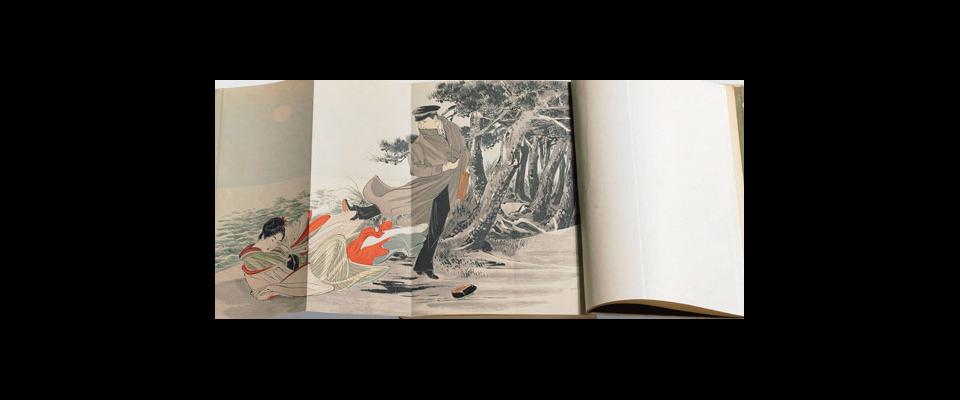For millennia, people have gathered at Berkeley’s rocks. They will again soon.
THEY COME AT DAY’S END TO SCAMPER up the steps carved in the south face of the rock and sit and watch the sun set. Or they come earlier in the day, often bearing crash pads, to climb on the slightly overhanging face in the grotto-like area on the back side, called “The Pit.” Sometimes they come as a class, to geologize, or to learn about the mortar rocks where, for thousands of years, the Ohlone ground acorns into mash.
The name of the place is Indian Rock Park. Scarcely an acre, it comprises a cluster of rhyolite outcroppings, deposited here by volcanic eruptions some 10 million years ago, when one-humped camels and three-toed horses and four-tusked elephants (Gomphotheres) wandered the continent.
The park is located in the hills, two miles from campus in the Northbrae district where many of the streets are named for the counties, legacy of a failed bid to make Berkeley the state capital. Rocks are a prominent feature of the neighborhood and many of the houses seem to sprout from the boulders, in keeping with Berkeley alum Charles Keeler’s ideal of the “Simple Home” that blends with nature.
You would hardly guess, but the golden age of Yosemite climbing was launched here at Indian Rock by an adventurous band of Cal students. Young David Brower, who went on to become one of the leading environmentalists of the 20th century, was one of the piton pioneers. Others included Bestor Robinson ’18, Jules Eichorn ’37, and Dick Leonard, J.D. ’32, who has been called “the father of modern rock climbing.” Legends all, and Cal grads to boot, they etched their names in the record of first ascents in Yosemite and across the West, but not before learning the ropes here—literally. It was at Indian Rock and nearby Cragmont that they developed the ropecraft and belay techniques that would allow them to climb more fearsome objectives elsewhere, with a modicum of safety.
Ropes are seldom used at Indian Rock these days. For decades, the name of the game here has been bouldering—a brand of climbing where the emphasis is on difficulty, not altitude. At one point in the 1970s, the hardest known boulder “problem” was located just up the street in Mortar Rock Park. A feat of endurance and gymnastic ability, the problem is called Nat’s Traverse, after Nat Smale, Ph.D. ’87 , now a professor of mathematics at University of Utah.
Before he dropped out of Cal and lit out for the Valley, Alex Honnold, subject of the 2019 Oscar-winning documentary Free Solo, bouldered at Indian Rock.
Of course, there are those rare climbers who combine extreme difficulty and altitude, ropes be damned. Before he dropped out of Cal and lit out for the Valley, Alex Honnold, subject of the 2019 Oscar-winning documentary Free Solo, bouldered at Indian Rock. Fans of the film will recall that the most tenuous section in Honnold’s heart-stopping ascent of El Capitan was called simply: “the Boulder Problem.”
But don’t be intimidated by the area’s impressive history. As John “the Vermin” Sherman noted in his Stone Crusade: A Historical Guide to Bouldering in America, Indian Rock is “a very social area” where locals flock after work “as much to hang out with their friends as to boulder.” The scene at Indian Rock is diverse, relaxed, and inclusive.
And remember: You can scale Indian Rock without being a climber. And you should, just as soon as we can all be social again. The aforementioned steps wend their way to the top gently enough for kids, seniors, and guitar-toting path wanderers. Once on top of the Rock, visitors gain a sweeping view out over the rooftops to the wide expanse of the Bay and the Golden Gate beyond—the same view that inspired the University’s founders to recall the lines of Bishop Berkeley, thereby giving campus—and the city that grew up around it—its name.
Pat Joseph is editor in chief of California.
From the Summer 2020 issue of California.





















